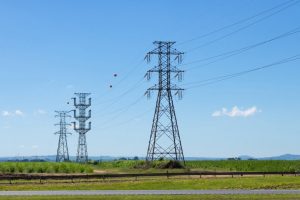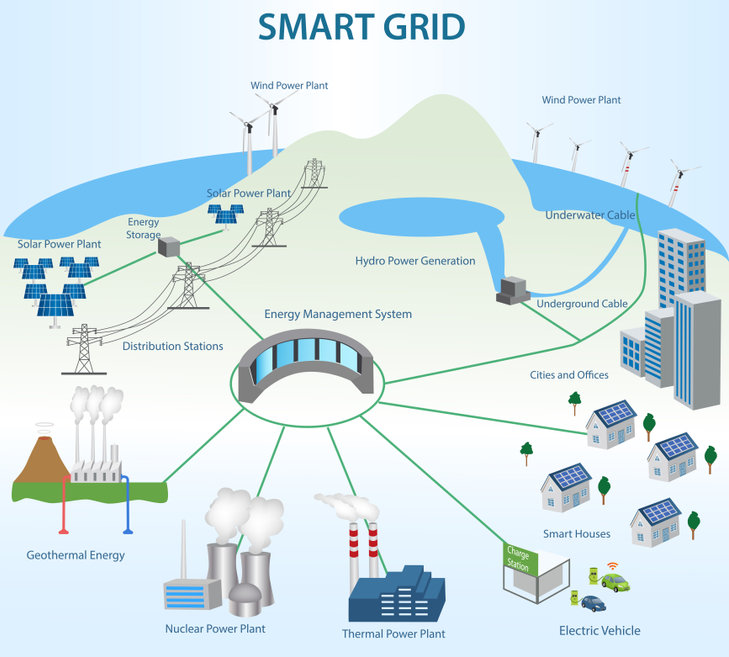CLICK HERE TO DOWNLOAD ACTIVITY 1
Purpose
- Provide an overview and timeline of the contest that explains the contest goals and procedures for each contest activity (1-7).
- Complete background reading to learn what AI is, how smart power grids differ from traditional power grids, the advantages of smart power grids, and how smart power grids aid areas before and after a storm.
- Assign team roles to each member to divide contest responsibilities.
- Develop a work plan and calendar to schedule time each week to work, meet with teachers, and mentors on activities.
Part 1: Contest Overview
In this design contest, your team will work together, just like a group of engineers would, to design a smart grid system run by artificial intelligence for your community. In this contest, you will learn about grid systems and how they operate. Then, your team will map the community around your school to identity and learn about the different types of power users that would be on the power grids. Your team will then take those users and think how to prioritize power distribution in the event of an emergency. Your team will then visualize energy consumption for those power users to learn about trends for those users which informs how your engineering team trains the smart grid system you are working towards. Then you are given a dashboard to test and refine how your engineering design team would redistribute power to optimize distribution to users over the course of a day. This data is what would be used to train a smart grid. The last task is to reimagine the grid layout of your community to give your team a chance to create microgrids with different users to help physically distribute power.
Part 2: Background Reading
Copyright: https://www.123rf.com/profile_aln23′>aln23</a>
Key Terms
Power plants – industrial electricity generators, traditionally from coal or natural gas
Loads – electricity consumers such as homes and businesses
Transmission lines – conductive cables that can transport energy throughout a state
Distribution lines – conductive cables that transport energy throughout neighborhoods
Transformers – increases (step-up) or decreases (step-down) the amount of power that is transmitted
Substations – areas that contain transformers to control power before it is distributed to the loadsc
What is “the grid”?
“The grid” refers to the traditional electric grid built in the 390s, still in use today. Since then, there have been many additions and improvements; however, the overall design has remained the same. Electricity moves in one direction from power plants to loads through a network of transmission and distribution lines, transformers, and substations.[4, 5]
In this system, power demands are estimated, and utility companies have no way to monitor energy flow once it leaves the plant.[6] Employees physically visit loads every month to read usage meters. We will soon outgrow this system with increasing electricity demands and reliance on technology. This is where the smart power grid comes in.
See the links below for more information about power grids:
- https://science.howstuffworks.com/environmental/energy/power5.htm
- https://www.science.smith.edu/~jcardell/Courses/EGR220/ElecPwr_HSW.html
- https://justenergy.com/blog/power-grid-what-is-it-and-how-does-it-work/
What is a smart power grid? How is it different from a traditional power grid?
A smart power grid consists of new technology, including controls, smart meters, computers, and automated systems to better provide for current and future energy needs. These changes allow for real-time two-way communication and management throughout the network.[4, 5]
 Copyright: https://www.123rf.com/profile_monicaodo’>monicaodo</a>
Copyright: https://www.123rf.com/profile_monicaodo’>monicaodo</a>
Advantages of smart grids over the traditional power grid:
- Better management and control: Traditionally, utilities estimate how much power is needed to supply a home, and an outage isn’t discovered until someone calls to report it. Smart grids allow both consumers and producers to monitor and control usage in real-time remotely. Thus, loads receive the exact amount of power needed, and outages are reported immediately.[4-7]
- Integration of advanced energy production and use: Infrastructure to support electric vehicles and renewable energy is developed to support more sustainable energy. Due to the two-way connection, buildings with solar cells can put excess energy back into the grid for distribution.[4, 5]
- Less centralized, more distributed: Traditional grids are centered around a few main power plants, while smart grids have a greater power supply distribution by utilizing consumer-owned generators and renewable energy sources. This minimizes the effect of an outage at a single plant and improves reliability.[4, 6]
- Lower energy cost: All the above advantages lower the cost of energy by simplifying utility management, reducing downtime from outages, and improving efficiency. Moving toward sustainable energy sources also reduces the impact of energy production on the environment.[4, 5, 7, 8]
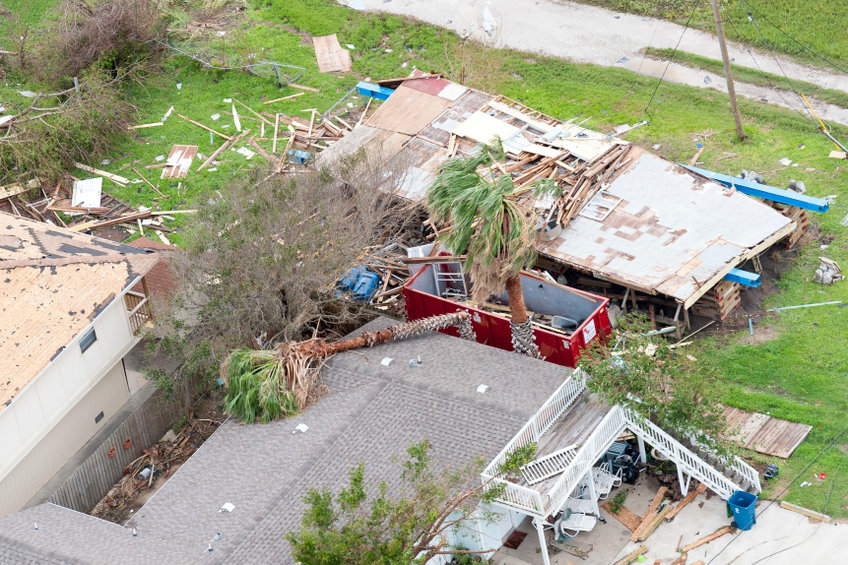
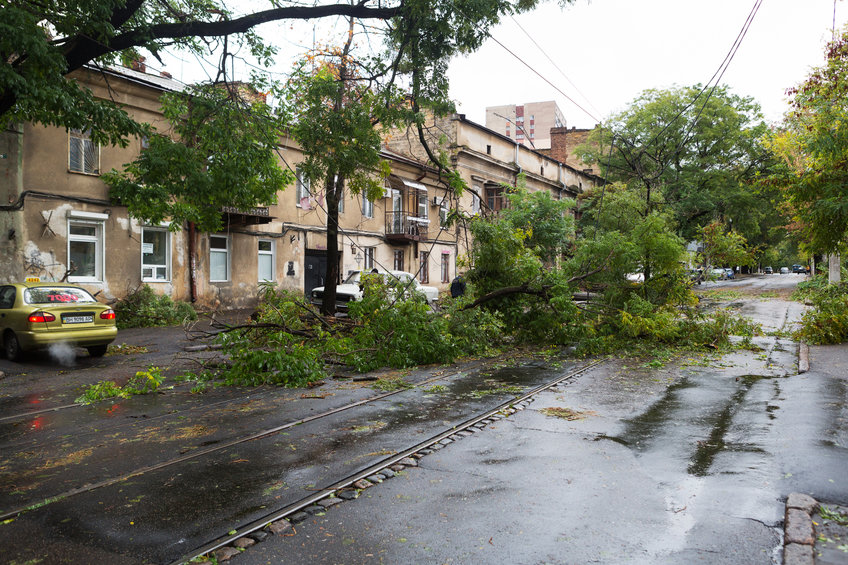
How do smart grids help during a natural disaster like a hurricane or tornado?
During a natural disaster such as a hurricane or tornado, strong winds and the debris that comes with it may easily knock down distribution lines. If there is flooding, the water must recede before substations can be accessed for repairs.[9-13] This could keep hospitals and other critical resources without power until long after the disaster. In the act of a natural disaster, many schools become active emergency shelters for those that need to evacuate an area or have a safe place to stay.[14]
The grid isn’t only vulnerable to natural disasters. Climate change has significantly increased both the frequency and intensity of heatwaves and winter storms.[11-13] These have the potential to melt distribution lines or freeze entire power plants.[13]
In a traditional grid, outages are not made known to the utility company until someone calls it in, and a team must be sent out to diagnose the issue before the right equipment is brought it. With a smart grid, the issue is immediately detected and remotely diagnosed. If available, power may be instantly rerouted, and the affected area will only notice a flicker in power.[6]
Of course, automation and remote controls alone cannot prevent large-scale blackouts during a disaster. Additional reinforcements or “hardening” are required to prevent the physical vulnerability of the grid during a natural disaster.[10, 11, 13] This may include switching from wooden distribution line poles to concrete, redesigning the infrastructure in flood zones, or moving lines underground. The smart grid does, however, reduce the time until the power is restored and provides useful information for future improvements. With the help of statistical modeling and AI, utility companies can use this data to better prepare for upcoming disasters and make decisions on which areas are most in need of hardening.[8, 10, 12, 13]
How is power restored after a storm?
Planning for power restoration begins long before disaster strikes. Electric companies run company-wide drills and make plans with the local government to prepare for different events.[16, 17]
Generally, the first step is to send out a team to assess the damage and ensure no power flows through downed lines. Power plants are the first to be fixed since they will provide power to the rest of the system. Next are transmission lines and substations. Water and wastewater plants are also restored to ensure emergency responders have a clean water supply. Power is then restored to emergency functions, including hospitals, police and fire stations, and communication systems. Once essential needs are met, distribution lines are fixed based on how quickly they can get power to the largest number of people. This includes lines that power whole neighborhoods, industries, or large businesses. Generally, the closer you are to a transmission line, the faster you will get power restored. Individual homes are the last step in power restoration.[16, 17]
Current ways power outages are reduced
Brownouts are a reduction in voltage that lasts for minutes to hours. They can be unintentional, such as during a storm or intentionally produced by utility companies. Voltage is decreased by 10-25%, and most electronics are not affected. In an emergency, a brownout is used to reduce power load and prevent a blackout. A blackout is a complete interruption of power in a given area. Planned outages or rolling blackouts may be implemented by utility companies for maintenance or to reduce stress on the system; however, blackouts are typically caused by natural disasters or catastrophic events.[15]
Energy vs. Power
Energy can be stored or converted into many forms, including kinetic, potential, and electrical. Some units that are used to measure energy are British thermal units (BTU), watt-hours (Wh), and joules (J). An electricity bill typically shows the total energy use by adding up the total kilowatt-hours (kWh) used over the course of a month. When looking at energy bills for different buildings, this value can only be compared if the measurements were taken over the same amount of time. For example, total kWh used over one year.[18]
We can also divide the energy measurement by the period over which it was taken to get a rate of energy usage or power. This can then be directly compared with other power measurements. Power can be measured in watts (W), which is simply 1 Joule per second (J/s), which makes it easier to see that power describes how much energy is used per unit of time. Thinking in terms of distance, energy is comparable to miles traveled, while power is comparable to speed in miles per hour.[18]
Relevant Research Papers
Use the research papers below to learn more about the information discussed in this activity. These can also be used as references for your final proposal presentation.
1. A Comprehensive Review on Smart Grids: Challenges and Opportunities
https://www.ncbi.nlm.nih.gov/pmc/articles/PMC8587637/
- This paper provides an overview of smart grids. It discusses the challenges and opportunities that smart grids bring to electrical power grids. This paper analyzes different aspects of smart grids like its technological advancements, challenges in implementation, and opportunities for enhancing energy management. Use this paper to get a better understanding of smart grids and how they are evolving.
2. A Comprehensive Review of Recent Advances in Smart Grids: A Sustainable Future with Renewable Energy Resources
- This paper gives an in-depth overview of developments in smart grids and the integration of renewable energy resources into smart grids. The goal of this paper is to understand how smart grids can support renewable energy integration in the future.
3. Recent Advancements in Smart Grid Technology: Future Prospect in the Electrical Power Network
https://www.sciencedirect.com/science/article/pii/S2090447920301064
- This paper explains smart grids and their implications for the electrical power network while highlighting the challenges in both production and distribution. Smart grids provide a solution to these challenges by enhancing the efficiency, reliability and sustainability of the electrical distribution system.
4. Overview of Smart Grid Implementation: Framework, Impact, Performance, and Challenges https://www.sciencedirect.com/science/article/abs/pii/S2352152X22000950
- This paper provides a survey of smart grid frameworks and their impact from 2015 to 2021 due to the increasing demand for electricity. Furthermore, the paper explores the framework of smart grids by examining its social, economic, and environmental impacts. It also provides information on how transforming traditional grids into smart grids works.
References
Artificial Intelligence
[1] Ivey, A. (2023, March 23). 7 artificial intelligence examples in Everyday Life. Cointelegraph. https://cointelegraph.com/news/7-artificial-intelligence-examples-in-everyday-life
[2] Kornowski, R. (2023, February 16). How artificial intelligence – ai – will change the future of Health Care: Opinion. North Jersey Media Group. https://www.northjersey.com/story/opinion/2023/02/10/aiwill-changethe-future-of-health-care/69885537007/
[3] How ai will permanently disrupt the education industry. Gold Penguin. (2023, September 4). https://goldpenguin.org/blog/how-ai-will-permanently-disrupt-the-education-industry/
Smart Grids
[4] Smart Grid: The smart grid. Smart Grid: The Smart Grid | SmartGrid.gov. (2019, December 16). https://smartgrid.gov/the_smart_grid/smart_grid.html
[5] Michaelson, H. (2021, February 24). Smart grids: Updating the traditional grid. Medium. https://medium.com/sjei/smart-grids-updating-the-traditional-grid-7979bed47761#:~:text=The%20traditional%20power%20grid%20moves,of%20energy%20into%20the%20grid.
[6] How the smart grid keeps your power on. What is Smart Energy? (n.d.). https://whatissmartenergy.org/how-the-smart-grid-keeps-your-power-on
[7] Smart Grid and power quality. What is Smart Energy? (n.d.-b). https://whatissmartenergy.org/smart-grid-and-power-quality
[8] Iea. (n.d.). Smart grids. IEA. https://www.iea.org/energy-system/electricity/smart-grids
Smart Grids and Natural Disasters
[9] Public Broadcasting Service. (n.d.). Hurricane Sandy and the limits of the smart grid | inside nova. PBS. https://www.pbs.org/wgbh/nova/insidenova/2012/11/hurricane-sandy-and-the-limits-of-the-smart-grid.html
[10] Author links open overlay panelMuhammad Waseem, & AbstractElectricity grid vulnerabilities can lead to outages with prolonged load interruptions. Research activities on the impact of natural disasters on power system are underway to figure out the outage reasons. (2020, November 3). Electricity Grid Resilience amid various natural disasters: Challenges and solutions. The Electricity Journal. https://www.sciencedirect.com/science/article/pii/S1040619020301561
[11] WP Company. (2021, October 24). Longer, more frequent outages afflict the U.S. power grid as states fail to prepare for climate change. The Washington Post. https://www.washingtonpost.com/business/2021/10/24/climate-change-power-outages/
[12] Sanstad, A. H., Authors, Sanstad, A. H., Larsen, P. H., & Eto, J. H. (n.d.). Case studies of the economic impacts of power interruptions and damage to electricity system infrastructure from extreme events. Case Studies of the Economic Impacts of Power Interruptions and Damage to Electricity System Infrastructure from Extreme Events | Electricity Markets and Policy Group. https://emp.lbl.gov/publications/case-studies-economic-impacts-power
[13] Dhanesha, N. (2021, December 2). The futuristic plan to fix America’s Power Grid. Vox. https://www.vox.com/recode/22812748/storm-hurricane-heatwave-climate-infrastructure-smart-grid-ai
[14] Home. FloridaDisaster.org. (n.d.). https://www.floridadisaster.org/
[15] Understanding brownouts and blackouts: Causes, effects, and solutions. California Commercial Generator Sales, Rental, Maintenance & Service. (2023, March 29). https://www.gotpower.com/brownouts-and-blackouts/
[16] Understanding the electric power industry’s response and restoration … (n.d.). https://www.eei.org/-/media/Project/EEI/Documents/Issues-and-Policy/Reliability-and-Emergency-Response/MA_101.pdf?la=en&hash=ED8AAD4C4C9B2EFA7B6A0A7663A15A6C03C61794
[17] ig.uana.16. (2021, April 15). How the Electric Company restores power after a Storm. Pro Tool Reviews. https://www.protoolreviews.com/how-power-restored-after-storm-order/
Energy vs. Power
[18] ig.uana.16. (2021a, April 15). How the Electric Company restores power after a Storm. Pro Tool Reviews. https://www.protoolreviews.com/how-power-restored-after-storm-order/
Part 3: Team Name and Assigning Team Roles
Decide together on a team name. Enter your team name at the top of this document and be sure to do so before you submit each contest activity.
Each of your team members is an equal participant in the design process IN ALL OF THE ACTIVITIES. Everyone has a voice and will share ideas to complete the contest objectives. Below is a table with four roles and their descriptions. Read the descriptions, and, as a group, decide who will take on what role. These roles each have key responsibilities that are important to your project’s success.
Instructions: Write each team member’s name in the table next to their assigned role.
|
Role Name |
Key Responsibilities |
Team Member Name |
|
Project Manager |
– Manages correct and on-time completion of Activity 1 – Keeps team on track with their team workplan – Ensures all activities are completed by all team members – Assigns tasks to themself and team members – Leads communications with team’s mentor |
|
|
Quality Engineer |
– Manages correct and on-time completion of Activity 2 – Reviews tables, graphs, and schematics for proper formatting – Edits activity submissions for proper grammar and formatting – Reviews and submits all activities – Reviews and edits final report |
|
|
Energy Analyst |
– Manages correct and on-time completion of Activities 3 and 4 – Leads team to quantify power consumption of different users – Leads team discussions about data analysis – Leads team discussions about AI design |
|
|
Design Architect |
– Manages correct and on-time completion of Activity 5 – Leads discussion on prioritization of different power users – Leads discussion on microgrid design – Leads team’s creation of final grid proposal |
|
Part 4: Activity Deliverables Checklist
Instructions: Read the Activity Deliverables Checklist to understand the different activity deliverables. Use the checklist to make sure your team has completed all the parts before you submit each Activity.
|
Activity Name |
Deliverables Checklist |
|
Activity 1: Setting Up for Success |
☐ Review Contest Overview and Timeline ☐ Complete Background Reading ☐ Assign Team Roles ☐ Review Activity Deliverables Checklist ☐ Develop Team Workplan and Calendar ☐ Activity 1 PDF submitted |
|
Activity 2: Mapping Your Community |
☐ Use Google MyMaps to locate your school ☐ Choose a radius to identify 10 unique users types and 50 users ☐ Priority rank 10 user types and count # of users ☐ Activity 2 PDF submitted |
|
Activity 3: Plotting Energy Consumption |
☐ Access and Launch Jupyter Notebook through Nanohub ☐ Enter your Users 1-10 ranked by priority ☐ Analyze daily and yearly energy consumption and identify trends ☐ Prework for Activity 4 ☐ Activity 3 PDF submitted |
|
Activity 4: Training Your Smart Grid |
☐ Setting the Scene – Power Plant AI Engineering Team ☐ What is “Artificial Intelligence” ☐ Training your smart grid in a partial outage ☐ Transfer your data ☐ Getting to know the dashboard ☐ Redistribute the power ☐ Activity 4 PDF submitted |
|
Activity 5: Reimagining the Grid |
☐ Executive Summary report PDF submitted ☐ Design Presentation PowerPoint PDF submitted ☐ Video Presentation MP4 submitted ☐ Activity 5 PDF submitted |
|
Activity 6A: Design Proposal, Report
Activity 6B: Feedback, Internal School Contests |
6A ☐ Executive Summary report PDF submitted ☐ Design Presentation PowerPoint PDF submitted ☐ Video Presentation MP4 submitted ☐ Activity 6A PDF submitted 6B ☐ Discussion with your team about other teams’ presentations ☐ Provide Feedback ☐ If there are more than 2 teams, Schools judge to select top two teams ☐ Activity 6B PDF submitted |
|
Activity 7: Design Showcase |
☐ Present to a panel of judges at UF ☐ Network with UF Engineering Students ☐ Take an Engineering Campus Tour |
Part 5: Team Work Plan and Calendar
Contest Activity Timeline
Below is an image of the Contest Activity Timeline. This timeline shows important dates of the contest that you should keep in mind to stay on track as you complete each of the Activities
Activity Completion Roadmap
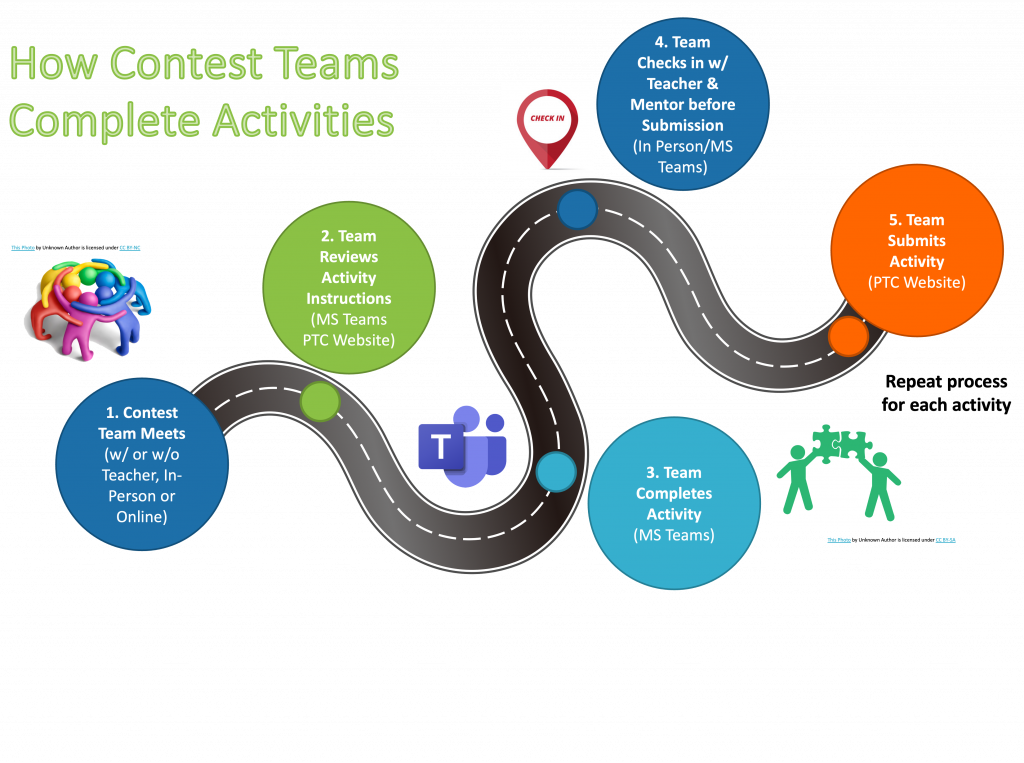 Team Workplan
Team Workplan
Instructions: Create an official contest workplan for your team. First, decide how often you will meet in-person to work as a team. Then, choose which days of the week work best for everyone to meet. Finally, choose times of the day that your team can meet to work together.
How many times a week will your team meet?
>
Which days of the week will your team meet? Highlight them below.
Monday Tuesday Wednesday Thursday Friday
What times of the day will your team meet?
>
Your mentor will virtually review each Activity the Thursday before you turn it in. However, you can also pick a weekly day and time to meet with your mentor for a guided work session. Mentor meetings should be between Monday and Wednesday.
Instructions: Use virtual chat or meet with your mentor to determine a day and time that works best for everyone in your team and your mentor.
Which day of the week will your team meet with your mentor? Highlight it below.
Monday Tuesday Wednesday
What time of the day will your team meet with your mentor?
>
You can refer to this document throughout the contest to check when you are meeting with your team, teacher, and mentor, and to make sure you are on track.
Instructions: Make your Team Work Plan official by entering it into a calendar. The blank calendar already includes the important contest deadlines.
Filling out your Team Work Calendar: Click a day in the blank calendar and write the details of your team work plan. While your cursor is in each box, use the paint bucket icon at the top of Word to highlight different scheduling items in different colors.
after completion:
- Meet with your team’s mentor to check your work and make changes as needed.
- Save this document as a PDF with the title Activity 1_[Team Name].pdf and then have your Quality Engineer submit your PDF here: https://ufl.qualtrics.com/jfe/form/SV_3wwsZbxwqu39mK2




